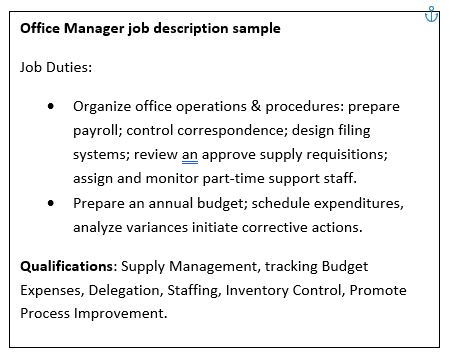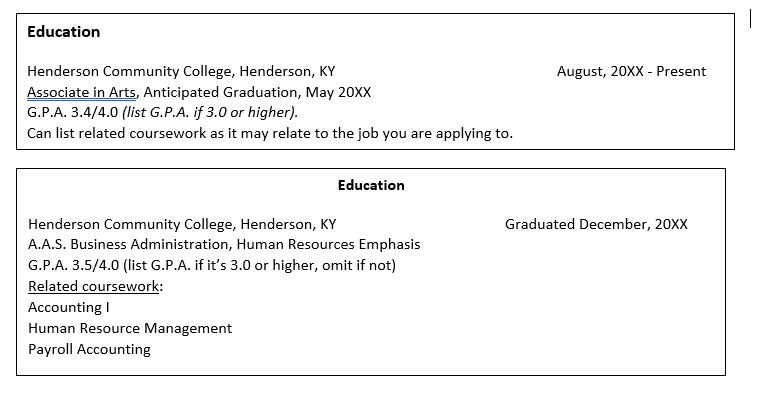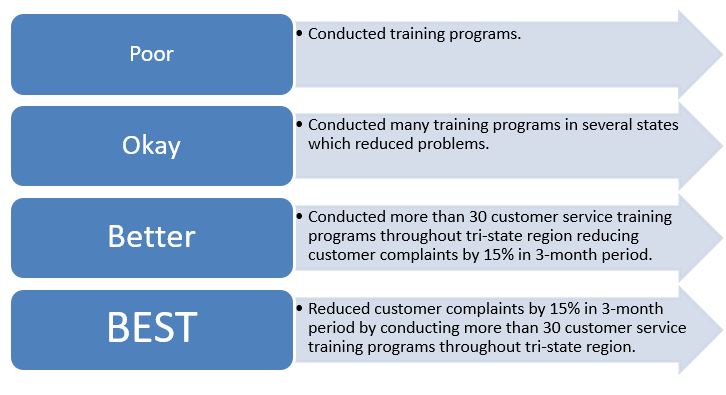
Healthcare Resume Guide
Table of Contents
- INTRODUCTION
- WHAT IS A RESUME AND HOW TO USE IT
- BRAINSTORM
- REVIEW JOB POSTING OR JOB DESCRIPTION
- RESUME WRITING STYLE
- RESUME MISTAKES
- RESUME FORMAT
- CHRONOLOGICAL
- COMBINATION/HYBRID
- FUNCTIONAL
- WRITING THE RESUME
- TYPICAL CHRONOLOGICAL FLOW
- SUMMARY
- SELF-DESCRIPTIVE WORDS
- EDUCATION
- WORK OR PROFESSIONAL EXPERIENCE
- POWERHOUSE ACTION VERBS
- ADDITIONAL SAMPLE SUMMARIES
- SAMPLE RESUMES
- NURSING
- BUSINESS ADMINISTRATION (HUMAN RESOURCES TRACK)
- BUSINESS ADMINISTRATION
- COMPUTER INFORMATION TECHNOLOGY
- INDUSTRIAL MAINTENANCE TECHNOLOGY
- ADVANCED MANUFACTURING TECHNICIAN
- BUSINESS ADMINISTRATION
- REFERENCES
- COVER LETTERS
- PARTS OF A COVER LETTER
- SAMPLE COVER LETTERS
- ADVANCED MANUFACTURING TECHNOLOGY
- PHLEBOTOMY
- ADVANCED MANUFACTURING TECHNOLOGY
- BUSINESS ADMINISTRATION (ACCOUNTING)
- SAMPLE THANK YOU LETTER (FOR AFTER THE INTERVIEW)
Introduction
What is a Resume and How to Use It
A resume is a marketing tool. You use it to sell yourself to a company. It shows
off achievements, attributes, strengths and a culmination of expertise to show how
you will add value to the organization. It never contains negative information or
weaknesses. The primary purpose of the resume is to obtain an interview.
Before you Start Writing Your Resume
Brainstorm
• List everything you have done professionally and academically.
List volunteer work and/or awards
• List awards or special recognitions

Review Job Posting or Job Description
If you do not have a job description or job posting, you can Google: “sample job description
of (job title)”.
· Highlight skills needed.
· Highlight keywords used.
· Compare your experience and education with the job requirements.

Identify skills needed and your skills.
Resume Writing Style
• Edit your core resume for each position.
• Use keywords found in the position description.
• Begin sentences or phrases with powerful action verbs. Watch your tenses!
o Use Present tense verbs for current position.
o Use Past tense verbs for previous positions.
• Avoid complete sentences – eliminate unnecessary or extra words such as a, an, the
• Avoid paragraphs as your important information will get lost in a paragraph.
• Proofread and ensure resume is free of spelling, grammatical, and typographical errors. (Don’t count on your computer’s spell check to catch everything. Have a trustworthy source proofread and do thoroughly proofread it at least once after printing it.)
Resume Mistakes
• Use the word RESUME on the top.
• Put a photo or any pictures on it.
• List any “personal” info on it such as age, race, religion, health, marital status, children, hobbies, social security number, height, weight)
• Use many different fonts or typeface styles.
• Use personal pronouns such as I, me, my, our, or their.
• Use “Responsibilities include…” or “Duties Include…” (we don’t want your resume to sound like a job description). Remember it’s a sales brochure!
• Use inappropriate or unprofessional email address.
• Use your work email or phone number as contact information. Employers don’t want to know you are using another employer’s time to look for a position.
Resume Formats
Chronological
• Presents resume with most recent experience first. Generally preferred by
Human Resources. Used if the majority of work experience/education relates to the
target position.
Combination/Hybrid
• Highlights skills or areas of expertise relevant to job requirements
• Provides chronological work history after highlighted accomplishments that employers prefer.
• Typically used for career changers
Functional
• Focuses on skills and experience.
• Eliminates work history.
• Typically use for those hiding gaps in their employment history
• Can be used for those with no experience at all, but chronological resume is preferred.
Writing the resume
Typical chronological flow:
• Header - Contact Information
• Summary
• Technical Skills (if applicable for IT students)
• Education**
• Work Experience
• Optional Sections such as Military Experience, Volunteer Experience and/or Community Service, Professional Development or Affiliations, Awards/Honors
** For individuals who have been out of school for more than 3-5 years of experience, move your Education section below the work experience as your work experience now needs to stand out.
Summary
Even though this section comes first on your resume, consider writing it last. Writing
the rest of your resume and identifying your achievements and skills will help you
write this section. Below this section is a list of self-descriptive words to review
and help you write a more professional summary.
A Summary tells the reader “Who YOU are and what YOU can do”. Below are the four elements with examples highlighted by italics:
1. Who are you professionally (job title)? Examples: Bookkeeper, Computer Programmer, Clinical Lab Technician
Who are you professionally highlighting your experience including Industry experience?
a. Marketing professional with over 2 years’ experience in product merchandising, sales, and customer relations.
b. Bookkeeper with A/R and A/P internship experience in manufacturing industry.
c. Cheerful and detail-oriented Registered Dental Hygienist with education and experience in oral hygiene dental treatments.
2. What are your functional/hard skills? What you learned on the job/volunteer work that relates to the target job that you do well.
a. Strong knowledge of machines and tools, including their uses, repair, and maintenance
b. Special expertise in patient management and making patients of all ages feel as relaxed and comfortable as possible, relieving any anxiety or tension they might have.
c. Experience and education in business and human resources including interviewing, record-keeping, and maintenance of employee files.
3. What are your strengths and abilities?
a. Communicates effectively with diverse clientele utilizing sound judgment and self-motivation.
b. Ability to communicate technical issues with non-technical people.
c. A team player who is attentive to detail and produces quality results.
d. A self-starter and capable of effectively functioning with minimum supervision
4. What type of contribution will you make? How will you add value?
a. ...earned a reputation for priority setting and team building.
b. …taking pride in creating efficiencies while maintaining quality results.
c. …Known for taking initiative and skilled at meeting challenges and deadlines.
Summary Sample
· Network Technician with a passion for problem solving to ensure customer satisfaction. Experience with setting up, testing, and debugging network. Known for configuring, testing, and troubleshooting narrowband systems and broadband systems. Plans, organizes, and prioritizes assigned projects with ability to balance multiple tasks. Communicates technical issues to non-technical people.
· Reliable, service focused Certified Nursing Assistant with excellent patient care and charting skills gained through training and work experience. BLS and CPR certified (current).
Education
• List the type of degree you have or will receive, your major, then the name
of the school/college, then city and state.
• If you have received several degrees, list the highest degree first.
• If you are receiving or have received a college degree, it is not necessary to list your high school or GED education.
• It is not necessary to list higher educational institutions that you attended but did not graduate from unless the credit hours you earned are relevant to the target position.
• List training, seminars, certifications.
If you are a new or recent graduate:
• List coursework or projects that are relevant to the position.
• List your GPA if it is 3.0 or higher.
• List their graduation year. After 3-5 years, remove to keep your resume ageless.

Work or Professional Experience
Describe your work experience even if it is not relevant to your target position because
employers are looking for skills that are transferable, commitment, and responsibility.
Include full-time and part-time employment, internships, co-op experience or externships.
List volunteer experience if it relates to the job.
Tips:
• Adapt your resume towards your target job.
• Write achievements that emphasize your hard and soft skills that are transferable to your target position.
• List your most important achievement first.
• List the company name, city and state, and the dates (in years) that you worked there.
• List only years. This gives your sales brochure a cleaner presentation. The Employment Application is the place for the details of your actual months/years of employment.
• Finally, you will list achievements using bullet points. Each achievement should start with a powerhouse action verb and highlight 2 elements:
o ACTIONS – how you did the achievement.
o RESULTS – the outcome or why you did the achievement. Quantify your results if possible.
§ Numbers sell. Use numbers wherever you can. Instead of “trained employees” say “trained 5 employees”.
ACTIONS (what was done) + RESULTS (measurable outcomes)
Responsibility: Operated cash register
Accomplishment: Operated and balanced cash register (ACTION) with 100% accuracy (RESULTS).
Responsibility: Designed maintenance programs.
Accomplishment: Designed and implemented preventative maintenance program (ACTION) that reduced equipment downtime by 20% and significantly increased order processing (RESULTS).
Responsibility: Bought office supplies
Accomplishment: Saved $5,000 annually on office supplies (RESULTS) by negotiating with an outside supply company for best prices (ACTION).
Achievements can be difficult to write so to help you, here’s another way to look at it:

Employers want to see how your achievements affect the bottom line of a company:
• How did you save the company money?
• How did you increase profits?
• How did you reduce costs or waste?
• How did you create efficiency? Did you identify and/or implement a more efficient way of doing a procedure or something in the office?
• How did you save time or reduce downtime?
• How did you go above-and-beyond or go that extra mile at school or at work?
• How did you solve a major problem?
• How did you provide exceptional customer service? Did you have a reputation for handling certain difficult problems, situations, or people?
• How did you bring in new customers/business?
• How did you reduce errors?
• How did you organize something?
Powerhouse Action Verbs
• The words that you use to describe your experience, activities and other categories
also convey the skills that you have developed and what you have to offer an employer.
• Using these powerhouse action verbs evokes confidence and authority and gets the employers attention. Start each accomplishment statement (bullet point) with a powerful action verbs.
Additional Sample Summaries - Often referred to as “Skills Summary”, “Profile”, or “Summary of Qualifications”
Dedicated Business and Management student with excellent critical thinking and leadership skills. Seeking a Summer internship in marketing/business development with a forward-moving company.
Enthusiastic Registered Nurse (RN) with experience in mental health unit. Developed well-built psychiatric-assessment and treatment-planning skills through current internship at Houston Department of Corrections. Aptitude to stay peaceful in urgent situations. Intervene during emergencies, facilitates groups and learning seminars, and collaborates on multidisciplinary teams. Demonstrated ability to build constructive relationships with patients, family members, physicians and other health professionals.
SUMMARY
Reliable, service-focused Phlebotomist with excellent venipuncture and capillary punctures, collection, and storage of samples. High level of accuracy in verifying medical records gained through 3 years of experience. BLS and CPR certified (current).
SUMMARY
Highly motivated Technical Support professional. Strong verbal, listening and written skills. Comfortable in interacting with all levels of the organization and public. Able to negotiate and problem solve quickly, accurately, and efficiently. Adept at multitasking to achieve individual and team goals. Diverse background includes sales, customer service and supervision. Committed to quality and excellence.
Profile
Financial professional who is a self-starter and capable of effectively functioning with minimum supervision. Known for taking initiative and skilled at meeting challenges and deadlines. A team player who is attentive to detail and produces quality results. Computer proficient. Areas of expertise include:
• Analysis • Detail Oriented
• Accounts Payable/Payroll • Multi-Tasks
• Microsoft Office • Organization/Prioritizing
• Written and Verbal Communications • Data Entry
Diligent Certified Nursing Assistant with excellent direct patient care skills. Experience with recording of vital signs, response to emergencies, and dementia and Alzheimer’s knowledge. Agile and responsive to patient and family needs. Team-oriented with clear verbal and written communication.
